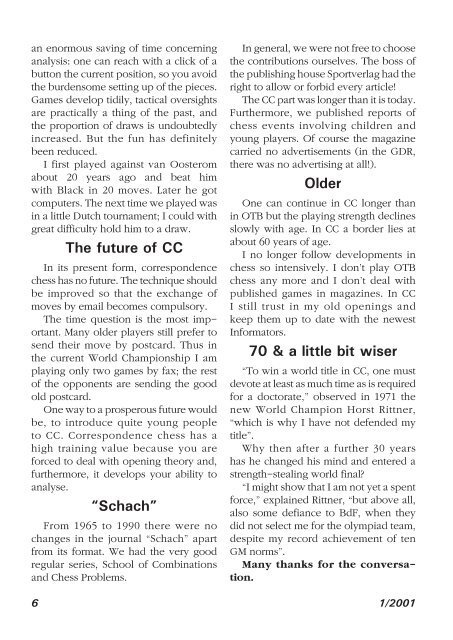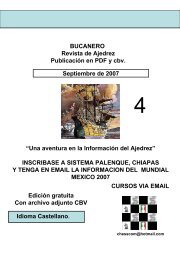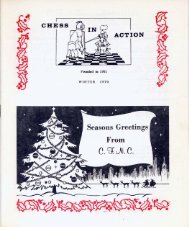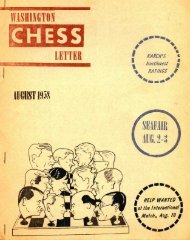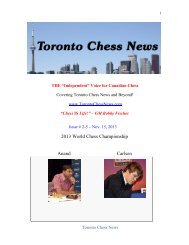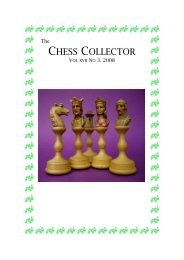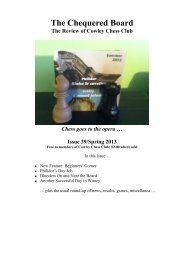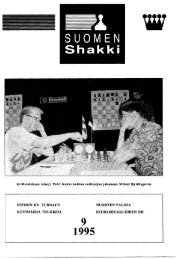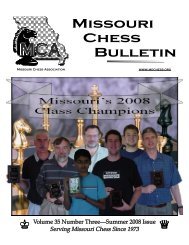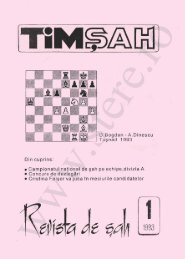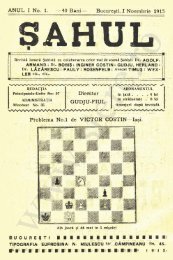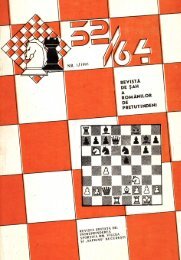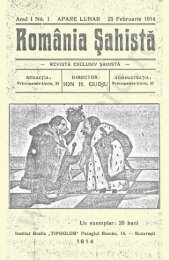Chess Mail
El ajedrez es un juego, considerado un deporte, entre dos personas, cada una de las cuales dispone de 16 piezas móviles que se colocan sobre un tablero dividido en 64 escaques. En su versión de competición está considerado como un deporte.
El ajedrez es un juego, considerado un deporte, entre dos personas, cada una de las cuales dispone de 16 piezas móviles que se colocan sobre un tablero dividido en 64 escaques. En su versión de competición está considerado como un deporte.
You also want an ePaper? Increase the reach of your titles
YUMPU automatically turns print PDFs into web optimized ePapers that Google loves.
an enormous saving of time concerning<br />
analysis: one can reach with a click of a<br />
button the current position, so you avoid<br />
the burdensome setting up of the pieces.<br />
Games develop tidily, tactical oversights<br />
are practically a thing of the past, and<br />
the proportion of draws is undoubtedly<br />
increased. But the fun has definitely<br />
been reduced.<br />
I first played against van Oosterom<br />
about 20 years ago and beat him<br />
with Black in 20 moves. Later he got<br />
computers. The next time we played was<br />
in a little Dutch tournament; I could with<br />
great difficulty hold him to a draw.<br />
The future of CC<br />
In its present form, correspondence<br />
chess has no future. The technique should<br />
be improved so that the exchange of<br />
moves by email becomes compulsory.<br />
The time question is the most important.<br />
Many older players still prefer to<br />
send their move by postcard. Thus in<br />
the current World Championship I am<br />
playing only two games by fax; the rest<br />
of the opponents are sending the good<br />
old postcard.<br />
One way to a prosperous future would<br />
be, to introduce quite young people<br />
to CC. Correspondence chess has a<br />
high training value because you are<br />
forced to deal with opening theory and,<br />
furthermore, it develops your ability to<br />
analyse.<br />
“Schach”<br />
From 1965 to 1990 there were no<br />
changes in the journal “Schach” apart<br />
from its format. We had the very good<br />
regular series, School of Combinations<br />
and <strong>Chess</strong> Problems.<br />
6<br />
In general, we were not free to choose<br />
the contributions ourselves. The boss of<br />
the publishing house Sportverlag had the<br />
right to allow or forbid every article!<br />
The CC part was longer than it is today.<br />
Furthermore, we published reports of<br />
chess events involving children and<br />
young players. Of course the magazine<br />
carried no advertisements (in the GDR,<br />
there was no advertising at all!).<br />
Older<br />
One can continue in CC longer than<br />
in OTB but the playing strength declines<br />
slowly with age. In CC a border lies at<br />
about 60 years of age.<br />
I no longer follow developments in<br />
chess so intensively. I don’t play OTB<br />
chess any more and I don’t deal with<br />
published games in magazines. In CC<br />
I still trust in my old openings and<br />
keep them up to date with the newest<br />
Informators.<br />
70 & a little bit wiser<br />
“To win a world title in CC, one must<br />
devote at least as much time as is required<br />
for a doctorate,” observed in 1971 the<br />
new World Champion Horst Rittner,<br />
“which is why I have not defended my<br />
title”.<br />
Why then after a further 30 years<br />
has he changed his mind and entered a<br />
strength-stealing world final?<br />
“I might show that I am not yet a spent<br />
force,” explained Rittner, “but above all,<br />
also some defiance to BdF, when they<br />
did not select me for the olympiad team,<br />
despite my record achievement of ten<br />
GM norms”.<br />
Many thanks for the conversation.<br />
1/2001


